|
|
|
Sort Order |
|
|
|
Items / Page
|
|
|
|
|
|
|
| Srl | Item |
| 1 |
ID:
150019
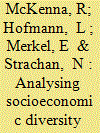

|
|
|
|
|
| Summary/Abstract |
Adequately accounting for interactions between Low Carbon Technologies (LCTs) at the building level and the overarching energy system means capturing the granularity associated with decentralised heat and power supply in residential buildings. The approach presented here adds novelty in terms of a realistic socioeconomic differentiation by employing dwelling/household archetypes (DHAs) and neighbourhood clusters at the Output Area (OA) level. These archetypes are combined with a mixed integer linear program (MILP) to generate optimum (minimum cost) technology configurations and operation schedules. Even in the baseline case, without any LCT penetration, a substantial deviation from the standard load profile (SLP) is encountered, suggesting that for some neighbourhoods this profile is not appropriate. With the application of LCTs, including heat pumps, micro-CHP and photovoltaic (PV), this effect is much stronger, including more negative residual load, more variability, and higher ramps with increased LCT penetration, and crucially different between neighbourhood clusters. The main policy implication of the study is the importance of understanding electrical load profiles at the neighbourhood level, because of the consequences they have for investment in the overarching energy system, including transmission and distribution infrastructure, and centralised generation plant. Further work should focus on attaining a superior socioeconomic differentiation between households.
|
|
|
|
|
|
|
|
|
|
|
|
|
|
|
|
| 2 |
ID:
176707
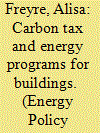

|
|
|
|
|
| Summary/Abstract |
Carbon tax is among the most intensively discussed topics in energy research and policy nowadays, but the question of using carbon tax revenue for environmental and energy policy purposes has received little attention so far. Currently the revenue generated from carbon tax has different usage in the countries worldwide, with only one quarter used for environmental and sustainable energy purposes. Against this background we study whether it can be advisable to use carbon tax revenue for financing energy efficiency and renewable energy (EERE) programs. Based on the case study of Switzerland, we demonstrate that such a policy approach could not only allow to achieve additional reduction of CO2 emissions, but also considerable net benefits to household sector with regard to reduction of heating costs, while having rather low program costs for individual households.
|
|
|
|
|
|
|
|
|
|
|
|
|
|
|
|
| 3 |
ID:
115116
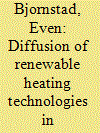

|
|
|
|
|
| Publication |
2012.
|
| Summary/Abstract |
A sample of 896 Norwegian households participating in a subsidy programme was surveyed in order to evaluate the success of the programme. The programme subsidised investments in new heating technologies, including heat pumps and pellet stoves. The success of the programme was measured by the degree of overall satisfaction with the investment by the sampled households. Theories on diffusion of innovations and planned behaviour motivate the empirical modelling of the investment satisfaction.
The economic return on the investment varied substantially both within and between the two heating technologies, with heat pumps outperforming pellet stoves in this respect. Still, the economic return showed no explanatory power toward the investment satisfaction of the household. Among the economic variables, only the electricity price had any influence on investment satisfaction. Technical quality, indoor climate and heat comfort, and the availability of the supplier of the heating equipment were the most important explanatory variables.
|
|
|
|
|
|
|
|
|
|
|
|
|
|
|
|
| 4 |
ID:
169887
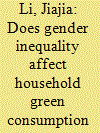

|
|
|
|
|
| Summary/Abstract |
In this paper, we examine whether gender inequality affects a household's decision to adopt green consumption behaviour in China. Building upon the literature that claims women tend to be more environmentally friendly than men, we hypothesise that households in which women play a stronger role adopt greener consumption lifestyles. Based on a nationwide survey, our empirical results show that households in counties with greater gender inequality use less energy-efficient electric products and are less willing to save energy. The results are robust to a number of variations in our empirical models. Social and economic factors are included to further explore the mechanisms underlying households' decisions. Our findings provide new insights into green development from a micro-level, bottom-up perspective. They are relevant for policy makers because they indicate that promoting gender equality can have a favourable impact on green development.
|
|
|
|
|
|
|
|
|
|
|
|
|
|
|
|
| 5 |
ID:
163567
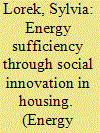

|
|
|
|
|
| Summary/Abstract |
Experience shows that energy savings through energy efficiency measures are partly compensated by income growth, and partly by rebound effects. Therefore to be effective, efficiency measures have to be embedded in a concept of sufficiency which strives for limits and absolute reduction of energy consumption. While the sufficiency concept is not new, it only recently gained attention in the field of housing. This paper provides a basis for broader and more informed debates in policy and research on the potential of sufficiency considerations to contribute to the overall reduction of energy consumption in the residential sector. It recommends shifting the attention from energy consumption of buildings towards a concept of sustainable homes in which e.g. the size of the living area plays a crucial role. A further important aspect is the possibility to fulfil other basic needs like the provision with food, recreation and social contacts in the nearby environment. The paper describes first examples of housing projects guided by sufficiency criteria, depicts the potential roles of different actor groups and points towards some general policy recommendations.
|
|
|
|
|
|
|
|
|
|
|
|
|
|
|
|
| 6 |
ID:
187019


|
|
|
|
|
| Summary/Abstract |
This study explores the impact of Technical and Vocational Education and Training (TVET) on households in Samoa, particularly those households that invested in the TVET qualification and certification of at least one member of their household. Significant benefits accrue to households through productive employment of the TVET-certified household member, and this study is one of a kind designed to gather some base line socio-economic data from 15 case study households to validate these claims. The study is framed within the sustainable livelihoods approach and capabilities approach. Improved skills of TVET persons provide a sustainable livelihood for their households and enabled strengthening of people's capabilities to make significant contributions to their families, community and national development agenda. Questionnaires and focus group discussions were methods engaged to answer the study question on the socio-economic impacts of TVET-certified members on their households. The results substantiated what we have always observed and believed, that the households with at least one TVET-certified member is able to make positive physical and social contributions towards improving the livelihood of the entire household.
|
|
|
|
|
|
|
|
|
|
|
|
|
|
|
|
| 7 |
ID:
171468


|
|
|
|
|
| Summary/Abstract |
In this article, we investigate the heterogeneity in the responsiveness of Swiss household electricity demand to changes in prices and income. We focus on segments of consumers with different intensities of electricity consumption by using a panel quantile regression approach. This estimation strategy is applied to a rich micro-level longitudinal data set of 3880 observations from more than 1400 households, matched with a unique price data set extracted from the Swiss electricity regulator's online sources. While the findings show an inelastic electricity demand across all groups, an interesting pattern of variation emerges between lower and upper quantiles of electricity demand, respectively frugal and intensive users. Results show that households in the first conditional quartile and at the median react significantly to changes in prices, while those at the lowest quantile and upper quantiles exhibit insignificant price elasticities. The main policy implications of this work concern the design of price-based measures for reducing electricity consumption in the residential sector and the possibility of accounting for individual responses in tailoring policies for specific consumer segments.
|
|
|
|
|
|
|
|
|
|
|
|
|
|
|
|
| 8 |
ID:
166515


|
|
|
|
|
| Summary/Abstract |
Based on a study of fifty initiatives aimed at reducing energy usage among Swiss households, we uncover what representations of change and forms of engagement are put forward by these initiatives, and the related policy implications. Two ideal-types emerge from our analysis: first, the dominant worldview of change as based on governing behaviour towards ‘better’ individual choices, made possible through rationalising, evaluating, and awareness-raising; second, an ideal-type which involves representations of change based on recognizing the social embeddedness of practices and socio-technical systems. Initiatives that fall into this category seek to transform how everyday life plays out, in relation to energy services and systems of provision, while challenging dominant norms around individuals as central to change. In comparing the Swiss case to over 1,000 initiatives across Europe, we discuss what makes Switzerland a forerunner in relation to this second ideal type. Further, we assess how different forms of engagement are at play, involving the participation of diverse groups of people in initiative design and implementation, while aiming towards more durable, effective and innovative solutions – which we see as a subset of the two ideal types, and one that merits further study.
|
|
|
|
|
|
|
|
|
|
|
|
|
|
|
|
| 9 |
ID:
186840


|
|
|
|
|
| Summary/Abstract |
There are inadequate empirical studies on non-farm livelihood choices of rural households in the state of West Bengal, India. This study aims to explore the determinants that effect the choice of households to engage in non-farm economic activities. The present study found that non-farm livelihood diversification factors are more heterogeneous and mainly depend on households’ strategic decisions. A household’s choice of non-farm livelihood activity is determined by binary aspects opportunity-driven versus distress-driven, but it is a complex transformation phenomenon. It has been noticed that within the non-farm livelihoods, share of wage labour (38.3%) is higher, followed by non-farm businesses (19.8%), service providers (18.0%), and salaried jobs (3.4%). The location and distance to the town from the households, food insecurity, and agricultural land size are more influential and statistically significant factors in choosing non-farm livelihood practices. The Mahatma Gandhi National Rural Employment Guarantee Act (MGNREGA) has negatively impacted rural non-farm livelihood activities. There is an 18% and 39% probability of reducing non-farm business and services compared to the increasing MGNREGA work opportunities. Moreover, the likelihood of non-farm business choices has increased by 56% due to rainfall and temperature-change-induced disasters.
|
|
|
|
|
|
|
|
|
|
|
|
|
|
|
|
| 10 |
ID:
166346
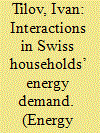

|
|
|
|
|
| Summary/Abstract |
This article analyzes the interactions and possible trade-offs between direct energy consumption and embodied energy requirement of households in Switzerland in order to assess the net impacts of standard energy policies focusing exclusively on direct energy use. Direct and embodied energy demand of Swiss households are estimated by combining consumption data of a national expenditure survey with data on energy intensity from life-cycle analysis. Using a system of equations and an instrumental variable approach, we find that both domains are driven by same determinants, but that there is no evidence for significant substitution between them. We also find an increasing effect of income on both domains, with particularly important effects on embodied energy. From a policy perspective, our findings highlight a concern that economic growth could bring about an increasing global energy demand through energy requirement for non-energy commodities. However, the wide-spread policies targeting direct energy are unlikely to cause a substantial shift in household consumption to embodied energy.
|
|
|
|
|
|
|
|
|
|
|
|
|
|
|
|
| 11 |
ID:
125141


|
|
|
|
|
| Publication |
2013.
|
| Summary/Abstract |
While fighting insurgency, both state and non-state groups depend on the local population for valuable resources such as food, intelligence, and security. By using a repertoire of subsistence coping mechanisms available to households in the context of the local political economy as an indicator of grievances and mechanisms of interactions between local households and the state and insurgents, district level data from Nepal on Maoist conflict is used to test hypotheses regarding state and insurgent violence. The analysis confirms that the state was more likely to kill people in a district where the number of households that borrowed to cope with subsistence was high. The Maoists were more likely to kill in a district with a higher number of subsistence sufficient households.
|
|
|
|
|
|
|
|
|
|
|
|
|
|
|
|
| 12 |
ID:
150657
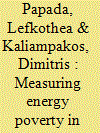

|
|
|
|
|
| Summary/Abstract |
A comprehensive research in the field of energy poverty is undertaken in this paper, in an attempt to highlight the great vulnerability of Greek households on energy poverty, in the middle of a severe economic crisis. Till now, Greek energy policy has been considered insufficient to tackle energy poverty issues, as focusing mainly on short-term rather than permanent solutions. A primary survey has been conducted, recording objective data of energy expenses as well as subjective perceptions about housing conditions. The findings showed that, under the objective expenditure-based method, 58% of Greek households are energy poor. Among households under the poverty threshold, the energy poverty rate exceeds 90%. Existing and new subjective indicators shed light on other aspects of energy poverty, such as the level of thermal comfort at home, damp problems detected, restriction of other essential needs in order to manage energy payments, etc. Some interesting conclusions are also drawn by exploring the relationship between various indicators. It appears that households considered energy poor are not identical when examined by objective and subjective indicators. However, different indicators complement each other by capturing different aspects of the problem and provide a broader overview of the issue.
|
|
|
|
|
|
|
|
|
|
|
|
|
|
|
|
| 13 |
ID:
096111


|
|
|
|
|
| Publication |
2010.
|
| Summary/Abstract |
Environmental problems in the energy system often originate from everyday activities and choices. Everyday activities in the home are part of the private sphere that can be contested in relation to energy policies. This article discusses the public-private divide in energy policies and how Swedish municipal energy consultants understand the divide. By analyzing the actions of energy consultants and their efforts to influence households, as well as how households perceive this guidance, I will discuss the public-private discourse in relation to energy policy and how this discourse can be a restriction for the energy consultants to reach their full potential.
The consultants found it problematic to discuss behavioral issues because they did not know how to relate to people's everyday life activities without intruding on private and personal matters. For the households tailored information and feedback was not perceived as the consultant trespassing in the private sphere. Instead, the householders highlight the possibilities of such mapping. Lessoned learned from Sweden is that state subsidies to local energy consultants is a good way to reach households, but that they need to develop their methods and use more tailored information.
|
|
|
|
|
|
|
|
|
|
|
|
|
|
|
|
| 14 |
ID:
171439


|
|
|
|
|
| Summary/Abstract |
The paper discusses the dynamics behind price-based incentives in demand response programmes promoting time shifting of energy consumption in households. Through a comparative analysis of smart energy pilots in Norway, Austria, and Denmark, the study shows that economic incentives under certain conditions influence energy-consuming practices of households but not in ways anticipated by widespread rational conceptualisations within economic, engineering, and policy-making approaches. The paper elaborates the practice-theoretical understanding of financial structures in smart energy interventions and identifies the socio-material configurations causing price to play a role. This informs policymakers and developers of future smart energy interventions. The overall policy recommendation of the paper is that smart energy designers, planners, and policymakers need to consider the complexity of interrelated elements that co-determine the effectiveness of price incentives. Thus, a successful coupling between price incentives and demand response actions can best be realised via a productive mixture of mutually supporting elements (engagements, devices, and competences). In addition, the paper provides specific recommendations related to the design of effective and workable price schemes that fit into the everyday lives of households.
|
|
|
|
|
|
|
|
|
|
|
|
|
|
|
|
| 15 |
ID:
166493


|
|
|
|
|
| Summary/Abstract |
In Australia, as elsewhere, household electricity infrastructure is changing: over one-fifth of Australian households have rooftop solar photovoltaics (PV), and there is growing opportunity to purchase household battery storage. Australia has the highest proportion of distributed (household-level) solar PV worldwide. There is, however, concern from Australian utilities and governments that increasing numbers of households will opt to leave the centralised electricity grid, as it becomes technically feasible and cost-effective for them to do so. In this paper we explore the motivations and decision making of off-grid households, through a case study of the State of Tasmania, Australia. Our empirical research involved identifying existing sources of off-grid data and undertaking a survey and interviews of off-grid households. We conceptualise off-grid households as an instance of scarce data – a contrast to the concept of big data. Drawing on insights from critical data studies, we show how scarce data can act as a barrier to effective governance, with energy policy making skewed towards governing data-rich policy areas.
|
|
|
|
|
|
|
|
|
|
|
|
|
|
|
|
| 16 |
ID:
176750


|
|
|
|
|
| Summary/Abstract |
Energy use and the resulting environmental impacts are interrelated with socioeconomic development of a certain region. What is more, the residential sector plays an important role as a major consumer of the energy. Thus, it is important to identify the underlying patterns of energy consumption and the resulting CO2 emission amidst the external shocks. This paper focuses on the case of residential energy consumption and CO2 emission in Lithuania over 2004–2016. This example is important given the context of shifts in the size and structure of population, economy and energy transformation in Lithuania that occurred over the period covered. The analysis relies on the index decomposition analysis and factorizes the changes in CO2 emission into the effects of population size, household size, dwelling area, energy intensity and carbon factor. The results indicate that decline in energy intensity and population played the most important role in pushing the CO2 emission down, yet these effects were offset by the changes in the lifestyle of the population (i.e. household size and dwelling area) along with increasing carbon factor. These findings are contrasted to the corresponding findings form the earlier studies around the world and the resulting policy implications are delivered.
|
|
|
|
|
|
|
|
|
|
|
|
|
|
|
|
| 17 |
ID:
133218


|
|
|
|
|
| Publication |
2014.
|
| Summary/Abstract |
Smart energy grids and smart meters are commonly expected to promote more sustainable ways of living. This paper presents a conceptual framework for analysing the different ways in which smart grid developments shape - and are shaped by - the everyday lives of residents. Drawing upon theories of social practices and the concept of informational governance, the framework discerns three categories of 'information flows': flows between household-members, flows between households and energy service providers, and flows between local and distant households. Based on interviews with Dutch stakeholders and observations at workshops we examine, for all three information flows, the changes in domestic energy practices and the social relations they help to create. The analysis reveals that new information flows may not produce more sustainable practices in linear and predictable ways. Instead, changes are contextual and emergent. Second, new possibilities for information sharing between households open up a terrain for new practices. Third, information flows affect social relationships in ways as illustrated by the debates on consumer privacy in the Netherlands. An exclusive focus on privacy, however, deviates attention from opportunities for information disclosure by energy providers, and from the significance of transparency issues in redefining relationships both within and between households.
|
|
|
|
|
|
|
|
|
|
|
|
|
|
|
|
| 18 |
ID:
176874


|
|
|
|
|
| Summary/Abstract |
This paper analyzes the direct impact of transport fuel price change on household welfare in India using a cross-sectional household consumption expenditure survey data. The results show that transport fuel is price elastic in both urban and rural areas across income groups, implying that the subsidy reform undertaken by the Government of India is an effective means to reduce the residential transport energy consumption. However, the relative welfare values show that lower- and middle-income groups remain more vulnerable to transport fuel price changes, thus, suggesting a regressive effect. Since households do not have an affordable substitution option for transport fuels like petrol and diesel, decarbonizing transport sector needs investing in alternate fuels, technology and infrastructure. However, for sustainability and inclusion to go hand-in-hand, mere switching to alternate or cleaner fuel sources is not sufficient. It is imperative to encourage the use of public transport in India, considering the increasing transport demand due to the rising middle-income population and rapid urbanization. Along with it, the policy makers could consider offsetting the subsidy removal by a targeted compensation scheme which will not just ensure making the transition more inclusive, but also serve as a long term sustainable development strategy.
|
|
|
|
|
|
|
|
|
|
|
|
|
|
|
|
|
|
|
|
|